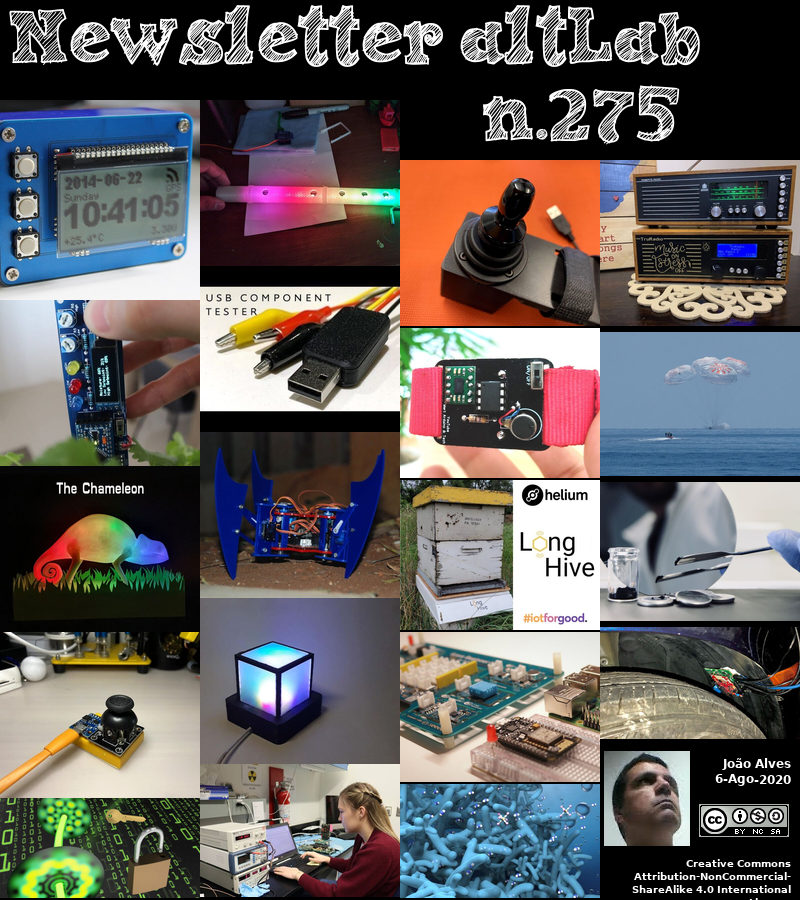2020-08-06 - Nº 275
Editorial
Esta é a Newsletter Nº 275 que se apresenta com o mesmo formato que as anteriores. Se gostar da Newsletter partilhe-a!
Todas as Newsletters encontram-se indexadas no link.
Esta Newsletter tem os seguintes tópicos:
Faz hoje anos que nascia, em 1667, o matemático suíço Johann Bernoulli. Ele ficou conhecido pela sua descoberta do cálculo exponencial (1691) e da equação da catenária (1690). A sua primeira publicação foi sobre o processo de fermentação (1690), mas depois disso, ele estudou e ensinou matemática ao longo da sua vida. Ele seguiu o seu irmão Jacques como professor de matemática em Basileia. Ele foi o primeiro a usar g para representar a aceleração devido à gravidade. Ele aplicou o então novo cálculo à medição de curvas, equações diferenciais e problemas mecânicos. Ele introduziu o famoso problema do braquistocromo. “Arquimedes de sua idade” estava inscrito em sua lápide.
Faz também hoje anos que nascia, em 1766, o químico e físico inglês William Hyde Wollaston. Ele é responsável pela descoberta do paládio (1803) e do ródio (1804), durante sua investigação do minério de platina. Ele desenvolveu um método de formação de platina - metalurgia do pó - e foi o primeiro a produzir platina maleável e dúctil em escala comercial. Ele tornou o seu método público na Royal Society em 28 de Novembro de 1828, pouco antes de sua morte. Em 1801, ele provou experimentalmente que a electricidade de atrito e a corrente são iguais. Ele é particularmente conhecido por ser o primeiro a observar linhas escuras no espectro do sol, que eventualmente levaram à descoberta dos elementos solares. Ele construiu o prisma Wollaston, um divisor de feixe polarizador (agora aplicado nos leitores de CD) e inventou a câmara lúcida.
Faz igualmente hoje anos que nascia, em 1881, o bacteriologista escocês Alexander Fleming. Ele ficou conhecido pela sua descoberta da penicilina. Em 1928, enquanto trabalhava no vírus influenza, ele observou que o mofo tinha-se desenvolvido acidentalmente numa placa de cultura de estafilococos e que o mofo tinha criado um círculo livre de bactérias em torno de si. Ele experimentou mais e descobriu que uma cultura de fungos impedia o crescimento de estafilococos, mesmo quando diluída 800 vezes. A substância activa, que chamou de penicilina, deu início à prática altamente eficaz da antibioticoterapia para doenças infecciosas. Fleming partilhou o Prémio Nobel de Fisiologia ou Medicina em 1945 com Ernst Boris Chain e Howard Walter Florey, que ambos (a partir de 1939) continuaram o trabalho de Fleming.
Por fim, faz hoje anos que nascia, em 1943, o cientista da computação americano Jon Postel. Ele desempenhou um papel fundamental na criação e administração da Internet. No final da década de 1960, Postel era um estudante de pós-graduação a desenvolver a ARPANET, um precursor da Internet para uso do Departamento de Defesa dos EUA. Como director da Autoridade para Atribuição de Números da Internet (IANA), que ele formou, Postel foi o criador do sistema de endereços da Internet. A Internet cresceu rapidamente na década de 1990 e existia a preocupação com a sua falta de regulamentação. Pouco antes de sua morte, Postel apresentou uma proposta ao governo dos EUA para uma organização internacional sem fins lucrativos que supervisionaria a Internet e seus nomes e números atribuídos.
Nesta semana que passou dois astronautas da NASA regressaram em segurança após o primeiro voo comercial da tripulação para a estação espacial. No passado domingo aterraram no golfo do México vindos da Estação Espacial Internacional. O Crew Dragon da SpaceX, carregando Robert Behnken e Douglas Hurley, caiu sob para-quedas no Golfo do México, na costa de Pensacola, Flórida, às 14h48. EDT domingo e foram recuperados com sucesso pela SpaceX.
Também nesta semana que passou foi lançada uma nova versão do Kernel Linux. Considerada por Linus Torvalds uma actualização "realmente grande", a versão 5.8 do Kernel foi lançada. Nesta nova versão destacam-se os drivers actualizados com suporte para uma serie de GPU adreno, patchs para a vulnerabilidade Spectre, melhorias no filesystem exFAT, driver de gestão de energia da AMD, capacidades de compressão no filesystem F2FS, entre outros.
Na Newsletter desta semana apresentamos diversas noticias, artigos científicos assim como projetos de maker.
 João Alves ([email protected])
João Alves ([email protected])
O conteúdo da Newsletter encontra-se sob a licença  Creative Commons Attribution-NonCommercial-ShareAlike 4.0 International License.
Creative Commons Attribution-NonCommercial-ShareAlike 4.0 International License.
Novidades da Semana

NASA Astronauts Safely Splash Down after First Commercial Crew Flight to Space Station
"Two NASA astronauts splashed down safely in the Gulf of Mexico Sunday for the first time in a commercially built and operated American crew spacecraft, returning from the International Space Station to complete a test flight that marks a new era in human spaceflight. SpaceX’s Crew Dragon, carrying Robert Behnken and Douglas Hurley, splashed down under parachutes in the Gulf of Mexico off the coast of Pensacola, Florida at 2:48 p.m. EDT Sunday and was successfully recovered by SpaceX. After returning to shore, the astronauts immediately will fly back to Houston. “Welcome home, Bob and Doug! Congratulations to the NASA and SpaceX teams for the incredible work to make this test flight possible,” said NASA Administrator Jim Bridenstine. “It’s a testament to what we can accomplish when we work together to do something once thought impossible." [...]

Linus Torvalds Releases the “Really Big” Linux Kernel 5.8
"Linus Torvalds has recently shipped Linux kernel 5,8, nearly a month of a half after he announced this release as a “really big” update that reminds of the 4.9 version. “I considered making an rc8 all the way to the last minute, but decided it's not just worth waiting another week when there aren't any big looming worries around,” Torvalds explains. New in this fresh version of the kernel are the updated drivers that add support for a series of Adreno GPU chips like the 405, 640, and 650 versions, the new Spectre patches, as well as exFAT refinements. Radeon drivers are also getting improved support in this release, and so is the POWER10 chip whose launch is currently projected to happen sometime next year. Lots of smaller changes But as Torvalds said back in June, Linux kernel 5.8 is a massive release because of all the small changes that are part of the update. And there are a lot of them, Torvalds originally said." [...]
Outras Notícias

Microchip Introduces New 8-Channel Flashtec® PCIe® Gen 4 Enterprise NVMe™ SSD Controller
"As data centers support more Artificial Intelligence (AI) and Machine Learning (ML) workloads, there is a need for cloud scale infrastructure that provides more bandwidth to storage and more storage density per rack. The trend is therefore to adopt PCIe® Gen 4-capable NVM Express™ (NVMe™) Solid State Drives (SSDs) in smaller form factors such as M.2 and the newer SNIA Enterprise and Data Center SSD Form Factor (EDSFF) E1.S form factors. These SSDs require controllers with optimized footprints and power while driving the NAND flash to its maximum potential and maintaining a rich feature set and the reliability demanded by this enterprise class of NVMe SSD. Microchip Technology Inc. (Nasdaq: MCHP) today announced its newest member of the Flashtec® family, the Flashtec NVMe 3108 PCIe Gen 4 enterprise NVMe SSD controller. The 8-channel Flashtec NVMe 3108 complements the 16-channel Flashtec NVMe 3016 and provides a full suite of PCIe Gen 4 NVMe SSD solutions to support a comprehensive set of data center storage requirements. Microchip’s new Flashtec NVMe 3108 PCIe Gen 4 NVMe SSD controller enables a variety of compact SSD form factors with efficient power and very compelling performance and reliability metrics while delivering industry leading security features." [...]

Virgin Galactic Unveils Mach 3 Aircraft Design for High Speed Travel, and Signs Memorandum of Understanding with Rolls-Royce
"Virgin Galactic Holdings, Inc, a vertically integrated aerospace and space travel company, which includes its manufacturer of advanced air and space vehicles, The Spaceship Company (“TSC”), announced today the first stage design scope for the build of its high speed aircraft design, and the signing of a non-binding Memorandum of Understanding (MOU) with Rolls-Royce to collaborate in designing and developing engine propulsion technology for high speed commercial aircraft. This follows the successful completion of its Mission Concept Review (“MCR”) program milestone and authorization from the Federal Aviation Administration’s (“FAA”) Center for Emerging Concepts and Innovation to work with Virgin Galactic to outline a certification framework. This marks an exciting step forward in Virgin Galactic’s development of a new generation of high speed aircraft, in partnership with industry and government leaders, with a focus on customer experience and environmental sustainability. Rolls-Royce is a leader in the cutting-edge technologies that deliver clean, safe and competitive solutions to the planet’s vital power needs. Rolls-Royce has a proven record of delivering high Mach propulsion, powering the only civil-certified commercial aircraft (Concorde) capable of supersonic flight. George Whitesides, Chief Space Officer, Virgin Galactic said, “We are excited to complete the Mission Concept Review and unveil this initial design concept of a high speed aircraft, which we envision as blending safe and reliable commercial travel with an unrivalled customer experience." [...]

FCC approves Amazon’s internet-from-space Kuiper constellation of 3,236 satellites
"The Federal Communications Commission has approved Amazon’s plans for its ambitious Kuiper constellation, which entails sending 3,236 satellites into orbit to beam internet coverage down to Earth. The decision is a crucial regulatory step that paves the way for Amazon to start launching the satellites when they’re ready. The company plans to send the satellites to three different altitudes, and it claims it needs just 578 satellites in orbit to begin service, according to an FCC document announcing the approval. Amazon said it will invest “more than $10 billion” in Project Kuiper in a blog post. Amazon has not announced which launch provider it plans to use to fly the satellites into orbit yet. While Amazon CEO Jeff Bezos also owns the rocket company Blue Origin, the launch provider will have to compete to launch the satellites along with other companies." [...]
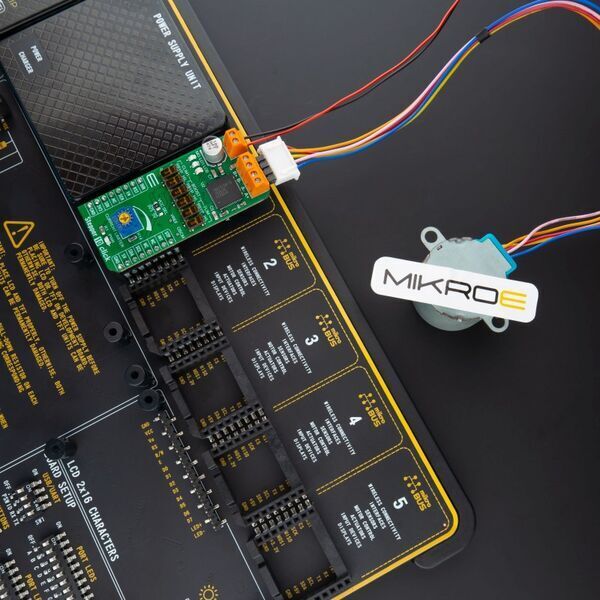
Toshiba Collaborates with MikroElektronika to Create Evaluation Boards for Motor Driver ICs
"Toshiba Electronic Devices & Storage Corporation ("Toshiba") today announces collaboration with MikroElektronika (“Mikroe”), a designer and manufacturer of hardware and software tools used to develop embedded systems. Customers are now able to evaluate Toshiba motor driver ICs on Click boards™, evaluation boards manufactured and sold by Mikroe. Toshiba’s highly integrated motor driver ICs, with a history stretching back more than four decades, are recognized across the industry for their utility in motor control systems. Toshiba provides a rich lineup of motor driver ICs for controlling brushed DC motors, brushless DC motors and stepper motors in diverse applications, including industrial equipment, home appliances, and office automation equipment. Toshiba motor driver ICs can now be easily evaluated using Click boards™ along with circuit diagram and sample software provided by Mikroe. All Click boards™ are fully compatible with any development board that hosts mikroBUS™ socket." [...]
Ciência e Tecnologia
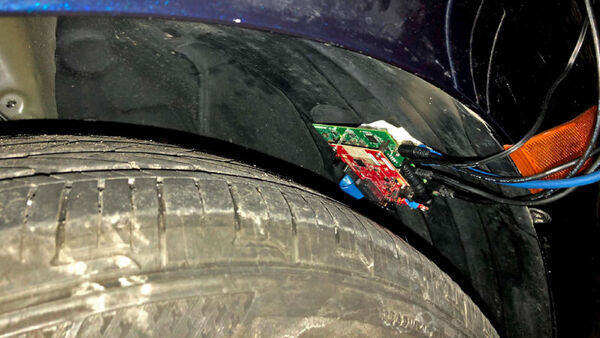
Sensing tire wear
"Researchers propose how we can we measure and monitor tire wear with tire wear sensors, increasing safety on the road, saving drivers money, and ultimately, saving lives. Has your car ever lost traction with the road during inclement weather? When car tires wear out, they pose a huge safety threat to vehicles and drivers. Although the lifespan of a tire depends on many factors, like the type of vehicle, driver habits, road conditions, and tire brand, drivers are encouraged to change their tires when the tread wears out. It was during a visit to Bridgestone Americas Technical Center in Akron, Ohio that researchers from Carnegie Mellon University; Akarsh Prabhakara, Vaibhav Singh, Swarun KumarOpens in new window, and Anthony RoweOpens in new window, came across this interesting problem: How can we measure and monitor tire wear? Today, every car has tire pressure sensors." [...]

Spintronics: Researchers show how to make non-magnetic materials magnetic
"A complex process can modify non-magnetic oxide materials in such a way to make them magnetic. The basis for this new phenomenon is controlled layer-by-layer growth of each material. An international research team with researchers from Martin Luther University Halle-Wittenberg (MLU) reported on their unexpected findings in the journal "Nature Communications". In solid-state physics, oxide layers only a few nanometres thick are known to form a so-called two-dimensional electron gas. These thin layers, separated from one another, are transparent and electrically insulating materials. However, when one thin layer grows on top of the other, a conductive area forms under certain conditions at the interface, which has a metallic shine." [...]

An electrical switch for magnetism
"NUS physicists have demonstrated the control of magnetism in a magnetic semiconductor via electrical means, paving the way for novel spintronic devices. Semiconductors are the heart of information-processing technologies. In the form of a transistor, semiconductors act as a switch for electrical charge, allowing switching between binary states zero and one. Magnetic materials, on the other hand, are an essential component for information storage devices. They exploit the spin degree of freedom of electrons to achieve memory functions. Magnetic semiconductors are a unique class of materials that allow control of both the electrical charge and spin, potentially enabling information processing and memory operations in a single platform." [...]

Promising new research identifies innovative approach for controlling defects in 3D printing
"Argonne scientists use temperature data to tune — and fix — defects in 3D-printed metallic parts. With its ability to yield parts with complex shapes and minimal waste, additive manufacturing has the potential to revolutionize the production of metallic components. That potential, however, is currently limited by one critical challenge: controlling defects in the process that can compromise the performance of 3D-printed materials. A new paper in the journal Additive Manufacturing points to a possible breakthrough solution: Use temperature data at the time of production to predict the formation of subsurface defects so they can be addressed right then and there. A team of researchers at the U.S. Department of Energy’s (DOE) Argonne National Laboratory, together with a colleague now at Texas A&M University, discovered the possibility. “Ultimately you would be able to print something and collect temperature data at the source and you could see if there were some abnormalities, and then fix them or start over,” said Aaron Greco, group manager for Argonne’s Interfacial Mechanics & Materials group in the Applied Materials Division (AMD) and a study author." [...]

May the force be with you: detecting ultrafast light by its force
"From cell phones to solar cells - research has implications for improvements in a wide range of technologies A McGill research team has developed a new technique to detect nano-sized imperfections in materials. They believe this discovery will lead to improvements in the optical detectors used in a wide range of technologies, from cell phones to cameras and fiber optics, as well as in solar cells. The researchers, led by Professor Peter Grutter from McGill’s Physics Department, used atomic force microscopy to detect the ultrafast forces that arise when light interacts with matter. In their paper, published this week in PNAS, they demonstrate that forces arising from two, time-delayed light pulses can be detected with sub-femtosecond precision (these are millionths of a billionth of a second) and nanometer spatial resolution in a wide range of materials. Improved technique for using light to detect imperfections in materials “To understand and improve materials, scientists typically use light pulses faster than 100 femtoseconds to explore how quickly reactions occur and determine the slowest steps in the process,” explains Zeno Schumacher, the paper’s first author who was a post-doctoral fellow in Grutter’s lab when the research was done and is now based at ETH Zurich. “The electric field of a light pulse oscillates every few femtoseconds and will push and pull on the atomic-sized charges and ions that comprise matter." [...]

Using viscous metals in micro fibers
"EPFL scientists have developed the first micro-structured fibers with a viscous metal inside – a perfect example of what cross-disciplinary teamwork can achieve. Platinum, copper, nickel and phosphorous – those are the components of an amorphous metal alloy with excellent mechanical properties. The alloy is also very corrosion-resistant and attract much interest in watchmaking and micromechanics. Now three scientists from EPFL’s Laboratory of Photonic Materials and Fiber Devices (FIMAP) – PhD student Inès Richard, postdoc Wei Yan and Professor Fabien Sorin – have given it a new purpose: they are using it to make electrodes for plastic fibers. Their paper, which was co-authored by Professor Jörg Löffler from ETH Zurich, has been published in Nature Nanotechnology. A thin electrical conductor “Our metallic glass is part of a new category of metals with an amorphous structure,” says Richard." [...]
Semiconductor Manufacturing Techniques Employed for New Gamma-ray Detector
"NASA astrophysicists and engineers are adapting detectors used by earthbound supercolliders and creating them the same way electronics companies produce all modern consumer devices, including cell phones and laptops. The new pixel-based silicon detector technology could be used on next-generation gamma-ray observatories to detect highly energetic photons emanating from the most powerful events in the universe, including colliding galaxies and black holes. The new detectors would sense these photons much like a digital camera and use far less power than current space-based detectors. Underground supercolliders, which have experiments employing the same silicon pixel-type detectors, accelerate protons and ions to near the speed of light in opposite directions at very high energies. Their collisions are designed to recreate the conditions that governed the universe after the Big Bang. Although highly efficient, current silicon pixel technology requires a lot of power, which would be a challenge if used in space where power is normally derived from solar panels." [...]

Neuronal cultures advance ‘brain-on-a-chip’ technology
"Lawrence Livermore National Laboratory (LLNL) researchers have increased the complexity of neuronal cultures grown on microelectrode arrays, a key step toward more accurately reproducing the cellular composition of the human brain outside the body. As described in a recently published paper in Scientific Reports, an LLNL team led by biomedical scientist Heather Enright cultured rodent-derived neurons on microelectrode arrays on a two-dimensional “brain-on-chip” device. They allowed the neuronal cultures to form networks, supplementing them with other cell types found in the brain -- astrocytes and oligodendrocytes -- which play a critical role in neuronal health and function. For more than a month in culture, the team monitored the neurons' electrical activity and characterized their molecular profile as they grew and matured over time. Researchers said the study establishes key differences between neuronal cultures of varying complexity, which will allow them to more accurately mimic the behavior of an animal brain in three-dimensional in vitro devices. “It was clear from what we had done in the earlier work that we needed to enhance the cellular complexity of these devices to more accurately recapitulate the function of the brain in an animal system,” Enright said." [...]
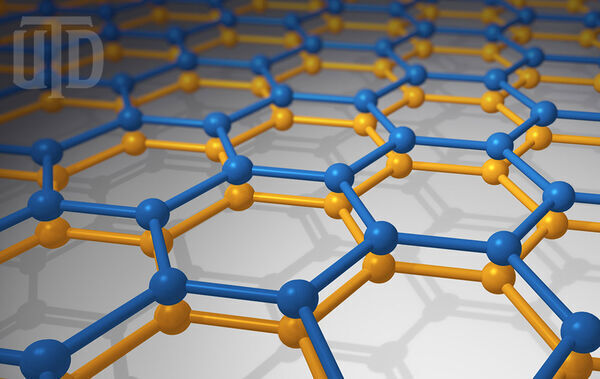
Physicists Find Misaligned Carbon Sheets Yield Unparalleled Properties
"A material composed of two one-atom-thick layers of carbon has grabbed the attention of physicists worldwide for its intriguing — and potentially exploitable — conductive properties. Dr. Fan Zhang, assistant professor of physics in the School of Natural Sciences and Mathematics at The University of Texas at Dallas, and physics doctoral student Qiyue Wang published an article in June with Dr. Fengnian Xia’s group at Yale University in Nature Photonics that describes how the ability of twisted bilayer graphene to conduct electrical current changes in response to mid-infrared light. From One to Two Layers Graphene is a single layer of carbon atoms arranged in a flat honeycomb pattern, where each hexagon is formed by six carbon atoms at its vertices. Since graphene’s first isolation in 2004, its unique properties have been intensely studied by scientists for potential use in advanced computers, materials and devices. If two sheets of graphene are stacked on top of one another, and one layer is rotated so that the layers are slightly out of alignment, the resulting physical configuration, called twisted bilayer graphene, yields electronic properties that differ significantly from those exhibited by a single layer alone or by two aligned layers." [...]

Sharing a secret … the quantum way
"Wits Researchers demonstrate a new quantum approach for sharing a secret amongst many parties, setting a new record for the highest dimensions and parties. Researchers at the University of the Witwatersrand in Johannesburg, South Africa, have demonstrated a record setting quantum protocol for sharing a secret amongst many parties. The team created an 11-dimensional quantum state and used it to share a secret amongst 10 parties. By using quantum tricks, the secret can only be unlocked if the parties trust one another. The work sets a new record for the dimension of the state (which impacts on how big the secret can be) and the number of parties with whom it is shared and is an important step towards distributing information securely across many nodes in a quantum network. Laser & Photonics Reviews published online the research by the Wits team led by Professor Andrew Forbes from the School of Physics at Wits University." [...]
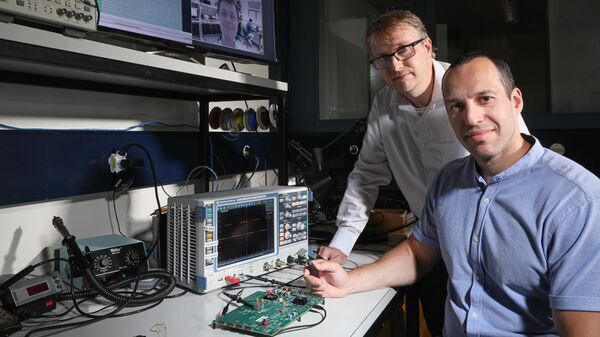
New high-capacity embedded memories use half as much silicon
"Researchers at EPFL and Bar Ilan University have developed a new type of embedded memory that takes up half as much space as traditional memory – and uses less energy – to store a given amount of data. The technology is being marketed through a new spin-off called RAAAM. Embedded memories play a crucial role in running our digital devices, from computers and smartphones all the way to the internet of things and entire telecom networks. In fact, embedded memory is what takes up most of the silicon surface inside those systems. Manufacturers are therefore looking for ways to shrink the amount of space that embedded memory takes up, so that they can develop devices that are smaller, cheaper and more powerful. A team of researchers from EPFL and Bar Ilan University (BIU) in Israel have taken a major step in that direction with a novel design that slashes the amount of silicon needed for a given amount of storage by 50%, while reducing the power requirement at the same time." [...]

Turning carbon dioxide into liquid fuel
"New electrocatalyst efficiently converts carbon dioxide into ethanol. Catalysts speed up chemical reactions and form the backbone of many industrial processes. For example, they are essential in transforming heavy oil into gasoline or jet fuel. Today, catalysts are involved in over 80 percent of all manufactured products. A research team, led by the U.S. Department of Energy’s (DOE) Argonne National Laboratory in collaboration with Northern Illinois University, has discovered a new electrocatalyst that converts carbon dioxide (CO2) and water into ethanol with very high energy efficiency, high selectivity for the desired final product and low cost. Ethanol is a particularly desirable commodity because it is an ingredient in nearly all U.S. gasoline and is widely used as an intermediate product in the chemical, pharmaceutical and cosmetics industries." [...]

Research Reveals How to Optimize Neural Networks on a Brain-Inspired Computer
"Neural networks in both biological settings and artificial intelligence distribute computation across their neurons to solve complex tasks. New research now shows how so-called “critical states” can be used to optimize artificial neural networks running on brain-inspired neuromorphic hardware. The study was carried out by scientists from Heidelberg University working within the Human Brain Project, and the Max-Planck-Institute for Dynamics and Self-Organization (MPIDS). The results have been published in Nature Communications. Many computational properties are maximized when the dynamics of a network are at a “critical point”, a state where systems can quickly change their overall characteristics in fundamental ways, transitioning e.g. between order and chaos or stability and instability." [...]
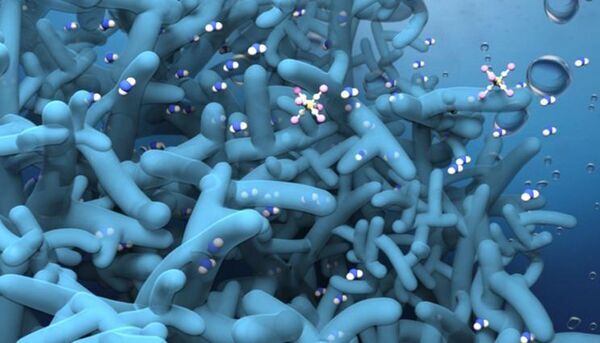
3D nanometer-thin membrane borrows from biology
"Mimicking the structure of the kidney, a team of scientists from Lawrence Livermore National Laboratory (LLNL) and the University of Illinois at Chicago (UIC) have created a three-dimensional nanometer (nm)-thin membrane that breaks the permeance-selectivity trade-off of artificial membranes. Highly permeable and selective membranes are useful for a wide range of applications, such as dialysis, water purification and energy storage. However, conventional synthetic membranes based on two-dimensional structures suffer from the trade-off limitation between permeability and selectivity, arising from their intrinsically limited surface area and long complex pore geometries. Taking a cue from biological systems that achieve a highly selective and rapid trans-membrane mass transport by employing efficient 3D functional structures, the team developed a self-supportive 3D membrane composed of two 3D interconnected channels, which are separated by a nanometer-thin porous titanium-oxide (TiO2) layer. This unique biomimetic 3D architecture dramatically increases the surface area, and thus the filtration area, by 6,000 times, coupled with an ultra-short diffusion distance through the 2-4-nm-thin selective layer. These features provide the 3D membrane's high separation performance with fast mass-transfer characteristics." [...]

New Study Presents Intrinsically Self-healable, Stretchable Thermoelectric Materials
"Researchers from UNIST have discovered a novel high-efficiency thermoelectric material that are intrinsically self-healable and highly stretchable. Their findings paved the way for discovery and development of smart clothes that harvest power from human body heat. A reasearch team, jointly led by Professor Sung-Yeon Jang in the School of Energy and Chemical Engineering at UNIST, in collaboration with Professor Ju-Won Jeon in the Department of Chemistry from Kookmin University, has developd the world’s first ionic thermoelectric (ITE) material with both good elasticity and self-healing abilities. Through the incorporation of self-healing properties in TE materials that generate power directly from the heat, the research team succeeded in synthesizing materials that possess intrinsic flexibility, stretchability, and self-healability all at once. With the advent of wearable technology products, such as smartwatches and VR glasses, there has been sufficient attention given to the research on thermoelectric generators (TEG) that convert body heat into electricity to power sensors. Thermoelectric generators (TEG) use TE materials, in which heat spontaneously flows when there is a temperature difference." [...]

Anode Material for Safe Batteries with a Long Cycle Life
"Researchers at Karlsruhe Institute of Technology (KIT) and Jilin University in Changchun/China investigated a highly promising anode material for future high-performance batteries – lithium lanthanum titanate with a perovskite crystal structure (LLTO). As the team reported in the Nature Communications journal, LLTO can improve the energy density, power density, charging rate, safety, and cycle life of batteries without requiring a decrease of the particle size from micro to nano scale. (DOI: 10.1038/s41467-020-17233-1) The demand for electric vehicles is increasing, accompanied by a growing need for smart grids that ensure a sustainable energy supply. These and other mobile and stationary technologies require suitable batteries. Storing as much energy as possible in the smallest possible space with the lowest possible weight – lithium-ion batteries (LIB) still meet this requirement best. The research aims at improving the energy density, power density, safety, and cycle life of these batteries." [...]

Project creates more powerful, versatile ultrafast laser pulse
"Institute of Optics research sets record for shortest laser pulse for newly developed technology, work that has important applications in engineering and biomedicine. University of Rochester researchers are setting a new standard when it comes to producing ultrafast laser pulses over a broader range of wavelengths than traditional laser sources. In work published in Physical Review Letters, William Renninger, an assistant professor of optics, along with members of his lab, describe a new device, called the “stretched-pulse soliton Kerr resonator,” that enhances the performance of ultrafast laser pulses. The work has important implications for a range of engineering and biomedical applications, including spectroscopy, frequency synthesis, distance ranging, pulse generation, and others. The device creates an ultrafast laser pulse—on the order of femtoseconds, or one quadrillionth of a second—that’s freed from the physical limits endemic to sources of laser light—what laser scientists call laser gain—and the limits of the sources’ wavelengths. “Simply put, this is the shortest pulse ever from a gain-free fiber source,” Renninger says." [...]
Projetos Maker
Diversos Projetos interessantes.
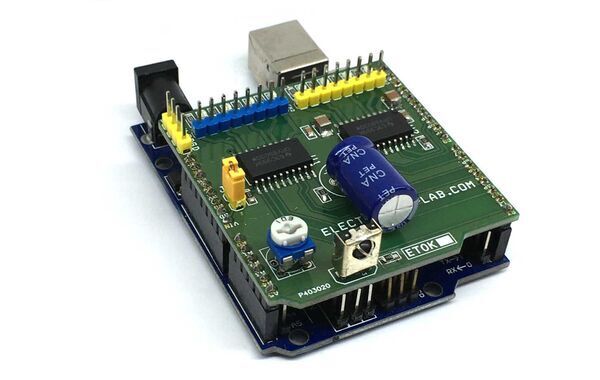
8 Channel Inductive Load Driver Arduino Shield
"The 8 Channel Driver Arduino UNO Shield is designed to enable users to switch inductive loads for up to 800mA each channel and up to 24V DC with no heat-sink needed. It is ideal for such applications as driving 2x unipolar stepper motors, solenoids, relays, and small DC motors. It uses 2x DRV8803 Chip from Texas instruments which is 4 channel low side driver with over current protection. IC’s Internal shutdown protection function is provided for overcurrent protection, short circuit protection, under-voltage lockout, and over temperature. Faults are indicated by a fault output pin that is normally high and goes low if a fault condition occurs. Reset and enable pins has internal pull-down resistors." [...]
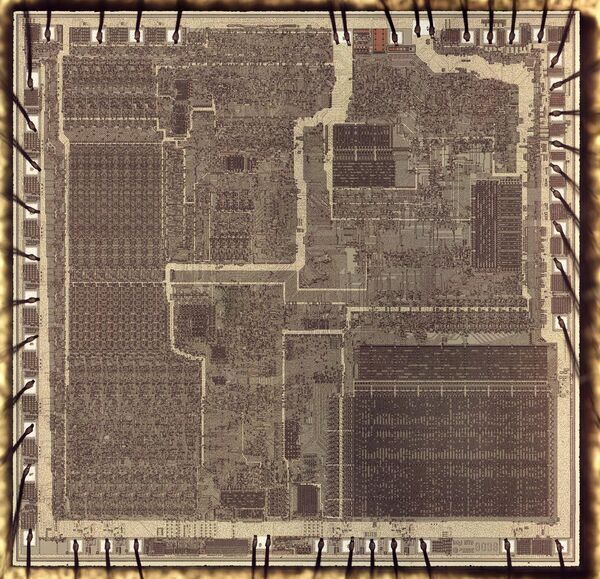
Inside the 8086 processor, tiny charge pumps create a negative voltage
"Introduced in 1978, the revolutionary Intel 8086 microprocessor led to the x86 processors used in most desktop and server computing today. This chip is built from digital circuits, as you would expect. However, it also has analog circuits: charge pumps that turn the 8086's 5-volt supply into a negative voltage to improve performance.1 I've been reverse-engineering the 8086 from die photos, and in this post I discuss the construction of these charge pumps and how they work. The photo above shows the tiny silicon die of the 8086 processor under a microscope. The metal layer on top of the chip is visible, with the silicon hidden underneath. Around the outside edge, bond wires connect pads on the die to the chip's 40 external pins." [...]
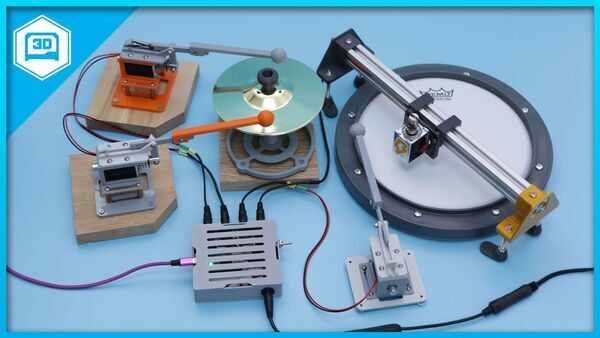
MIDI Solenoid Drum Kit
"Build a MIDI drum kit using solenoids and CircuitPython! 3D print parts to create a solenoid driven mallet to trigger snare drums, cymbals and much more! Use the Adafruit Feather M4 and ULN2803A darlington driver to create your own custom USB MIDI percussion ensemble. The Feather M4 and ULN2803A darlington driver are fitted onto a Perma-Proto board housed inside a snap fit case. DC jacks on the side of the case allow for plug and play of the solenoids. DIY your own cymbals, tom toms, snare and kick drum." [...]
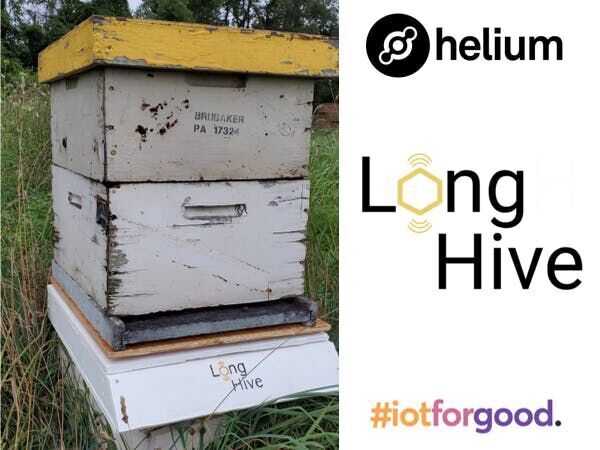
LongHive
"An end-to-end beehive monitoring solution enabled by the Helium Network and deep learning. Bees are critical to the livelihood of our ecosystem, but unfortunately in the past decade, bee populations have decreased by 30% [1]. In addition to the ecological impact, this instability poses an economic threat to the commercial honey bee pollination industry, which is valued at over $10 billion annually in the U.S. alone [2]. Much of the decline is attributed to a complicated phenomenon known as Colony Collapse Disorder (CCD), which results in the hive’s rapid abandonment of their queen, but the causes of CCD are not well understood. Whether you are an individual hobbyist or a commercial farmer who relies on large-scale pollination, monitoring your hive with simple sensory data can help beekeepers detect problematic trends in colony health. Our project, known as “LongHive”, is a full-service infrastructure for beehive maintenance, enabled by the Helium Network and Deep Learning (DL)." [...]

USB Component Tester
"Being an electronics engineer, I always wanted to have a portable component tester, which could test every electronic component out there. In 2016, I built myself a Component Tester based on AVR TransistorTester by Markus F. and Karl-Heinz Kübbeler. Following that, I redesigned the Component Tester to size of a keychain. Since makers, engineers and hobbyists have a computer around our work-desk always. So I thought to myself why not build a component tester that could be used as a USB accessory which allow us to test the components. I have designed a software to go along with the USB component tester that displays the required test parameters on display in a minimal design form." [...]
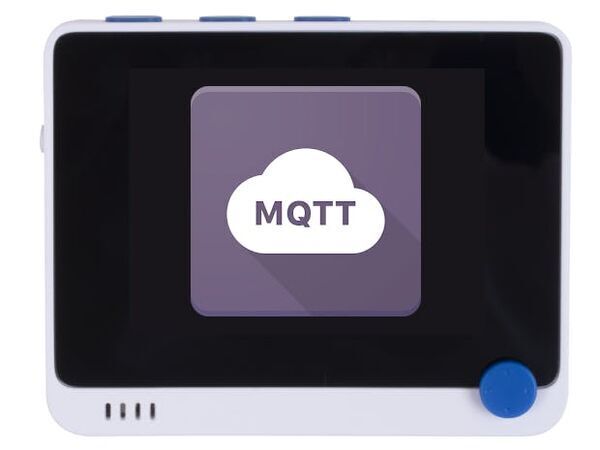
MQTT on Wio Terminal
"MQTT Pub/Sub on Wio Terminal. TL;DR: We are going to look at the MQTT Protocol on the Seeed Wio Terminal, Publish and Subscribe Topic over the MQTTon the Wio Terminal, and I'll show how to transfer data between Wio terminal and Mobile Phone or any device* using MQTT. Introduction to MQTT MQTT is an OASIS standard messaging protocol for the Internet of Things (IoT). It is designed as an extremely lightweight publish/subscribe messaging transport that is ideal for connecting remote devices with a small code footprint and minimal network bandwidth. MQTT today is used in a wide variety of industries, such as automotive, manufacturing, telecommunications, oil and gas, etc. The protocol was invented in 1999 by Andy Stanford-Clark (IBM) and Arlen Nipper (Arcom, now Cirrus Link)." [...]

ATtiny85 Wearable Vibrating Activity Tracking Watch
"How to make the wearable activity tracking watch? This is a wearable gadget designed to vibrate when it detects stagnation. Do you spend most of your time on the computer like me? Are you sitting for hours without realizing it? Then this device is for you :) I made a fun introduction to this project, I think you should watch it :) This is what inspired the Vibrating Watch, a simple activity tracker that will notify you when you are inactive for a pre-set period of time. In this project, we'll build a wearable gadget designed to vibrate when it detects stagnation." [...]

"Connect" to an atomic clock in space! GPS, DCF77
"This project is a clock with radio receivers which can receive the exact time from the GPS satellites or from the DCF77 transmitter. This project is a clock with radio receivers which can receive the exact date and time from the DCF77 time signal transmitter or the UTC from the GPS satellites and display it on a 128x64 pixel graphic display. DCF77 transmitter and GPS is synchronized to an atomic clock. So basically this project can "connect to" an atomic clock. This project is an open design: open hardware and open source software. Objectives: - receiving date and time from the DCF77 transmitter, decoding it, displaying it on a 128x64 pixel dotmatrix display - receiving UTC from GPS satellites with a GPS module, displaying it on a 128x64 pixel dotmatrix display - stand-alone date and time clock based on a real time clock (if radio signal reception is not possible) - measuring and displaying temperature - measuring and displaying battery voltage - displaying SW version information - simple menu system for configuration - alarm function - beep sound on button press I built the project around a PIC microcontroller." [...]
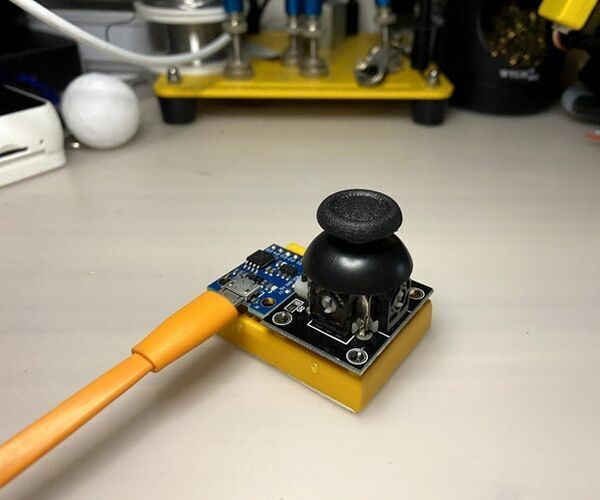
Tiny USB Joystick
"This instuctables show how to make a very simple tiny USB joystick. This instructables is related to Hall Effect USB Joystick for providing a low cost solution. " [...]

Getting Started with STM8S using STVD and Cosmic C Compiler
"Last time we examined how to program the STM8s microcontroller using the Arduino IDE. This way may work for developers who are familiar with the IDE and want to build quickly, and professional projects, but there are more ways to get the same result. Thus for today’s tutorial, we are going to examine how to use traditional tools like the Cosmic C compiler along with STVD to program the STM8s microcontrollers. There are several members of the STM8s microcontroller out there but for this tutorial, we will work with the STM8S103F3P6 microcontroller which is one of the cheapest, and most popular member of the family. The popularity of the STM8S103F3P6 makes it a perfect microcontroller for beginners as you can easily find support for it across several forums on the internet. For easy prototyping, we will use the STM8sBlue development board which is essentially a breakout board for the STM8S103F3P6 MCU with a USB interface, breadboard compatibility, and a few other components to facilitate the development of prototypes for projects based on the MCU." [...]

Roberts RM33 Raspberry Pi Internet Radio (Yet Another)
"Yes, it is another Raspberry Pi internet radio build and not my first one either. I am not sure why this build is still such a popular one, but I do still enjoy it and cannot say this one will be my last either. I really love the look of the Roberts radios of the early 80’s and started thinking of converting one to an internet radio. My goal was to maintain the same look and interface of the radio but replace the insides and give it a digital display. I really loved the mechanical feel and sound of the switches and the RM33 gave me lots of extra buttons to program. I kept the concept of the radio like the original RM33 using the 3 center selection buttons for Radio, Spotify and Soundcloud." [...]
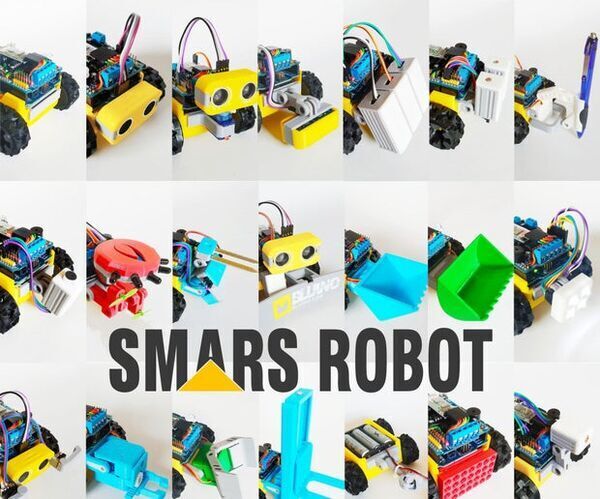
How to Build SMARS Robot - Arduino Smart Robot Tank Bluetooth
"To build the basic model of SMARS robot you just need few parts. Divided into two main parts, 3D printed parts and electronics components. For 3D parts you can print yourself using a 3D printer, you can download the complete 3D files here. For electronic components you can buy on Amazon or AliExpress. Electronics parts: 1 x Arduino Uno R3 DIP 1 x Arduino Motor Shield 1 x Ultrasonic HC-SR04 1 x IR Sensor 2 x Geared Motor 200 RPM 6V 8 x Cable jumper female to female 10cm 4 x Cable AWG24 1 x Connector 9V Battery 1 x 9V battery 1 x Battery Holder (2 x Li-ion 14500) 1 x USB Cable 1 x USB OTG" [...]
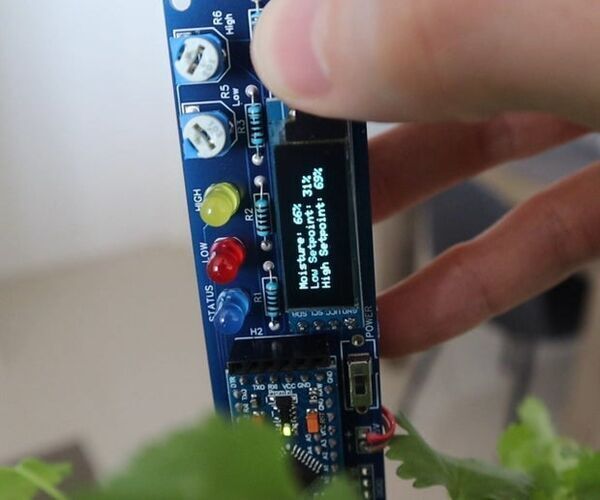
Arduino Soil Moisture Monitoring Stick - Never Forget to Water Your Plants
"Do you often forget to water your indoor plants? Or perhaps you give them too much attention and over water them? If you do, then you should make yourself a battery-powered soil moisture monitoring stick. This monitor uses a capacitive soil moisture sensor and a 3.3V Arduino Pro Mini to continuously monitor the soil moisture level and alert you when you're over or under watering your plants. Two potentiometers on the board allow you to adjust and set a high and low moisture level setpoint which trigger the flashing of two LEDs to alert you. You can also easily add a buzzer to the circuit if you'd like an audible alarm as well." [...]

The Chameleon
"The Chameleon is a portable ambient lamp. By pressing the push button changes the color. It starts with bright white, then red, orange, yellow, green, blue, indigo, violet and finally an animation with all the Rainbow Colors that simulates a colored camouflage. Supplies: - Arduino Nano V3.0 - SK6812 RGBW LEDs - Push Button - Switch - 5V 18650 Lithium Battery Boost Step Up Module Charger - 18650 Rechargeable Battery NCR18650B. - 3mm Fiber optic cable - 3M 6mm + 6mm Hexagonal Spacers. 3M Nuts." [...]
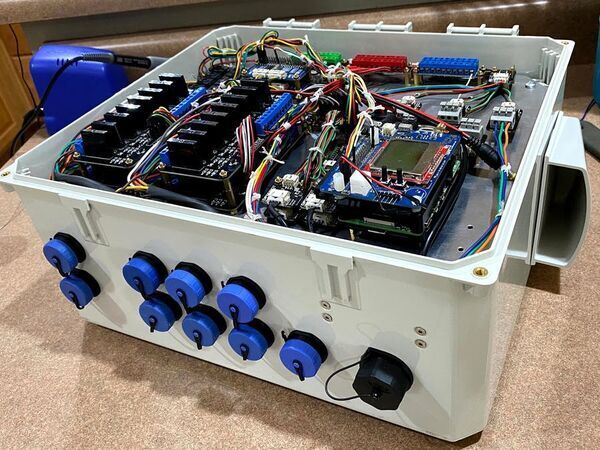
GardenPi powered by Neptune. py
"Highly scalable and powerful irrigation / hydroponic & aquaponic control system managing up to 32 zones with automation and sensors. Overview & Theory of Operation GardenPi, powered by Neptune.py is designed to manage, monitor, and control a series or sprinkler valves and a multitude of sensors for pretty much any sized irrigation / hydroponic/aquaponics project. It can be scaled (using the hardware I used) from 1 to 32 zones for water and 7 zones for power. It is built almost entirely in Python3 with a Flask web interface and relies on a lot of css to make the interface very fast. It is written and designed to run on the Raspberry Pi 4. GardenPi was designed around my family's desire to get more heavily into gardening, hydroponics, and eventually aquaponics." [...]
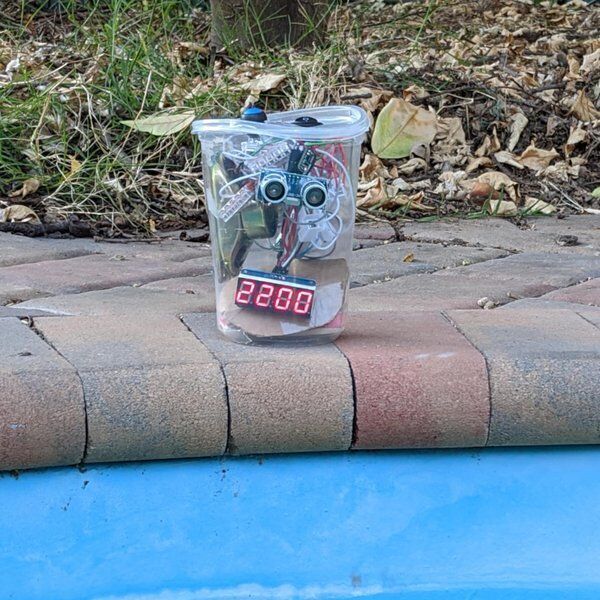
Swimming Pool Lap Counter
"I swim for exercise - sometimes I zone out and forget how many laps I've swam. This will keep track for me. I swim for exercise and occasionally do open water swims and triathlons. I want to swim a set distance and I keep track of how far I've swam in my head. Sometimes I zone out and forget exactly how far I've gone. This project is to build a lap counter so I don't have to remember." [...]

Smart Home IoT System Based on Raspberry Pi 4
"A smart home system helps users control household devices with web UI or Tmall Elf. (Author: Huang Hao, Wu Shu)" [...]
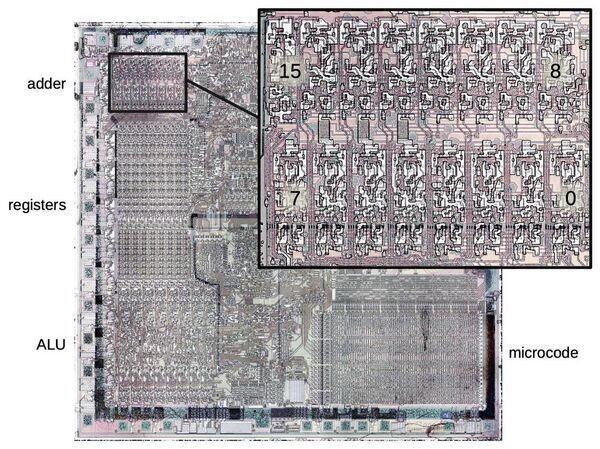
Reverse-engineering the adder inside the Intel 8086
"The Intel 8086 processor contains many interesting components that can be understood through reverse engineering. In this article, I'll discuss the adder that is used for address calculations. The photo below shows the tiny silicon die of the 8086 processor under a microscope. The left part of the chip has the 16-bit datapath including the registers and the Arithmetic-Logic Unit (ALU); you can see the pattern of circuitry repeated 16 times. The rectangle in the lower-right is the microcode ROM, defining the execution of each instruction. The 16-bit adder, the topic of this post, is in the upper left." [...]

Running a MQTT Broker on Raspberry Pi
"This project gives you an overview on MQTT and helps you setup a mosquitto MQTT server on a Raspberry Pi. We will send some Dummy data too. In the fast-changing world of IoT, there’s no such thing as a universal standard. But over the last few years, MQTT has started to establish itself as the de facto messaging protocol. In this tutorial you’ll learn how to set up an MQTT message server in just a few minutes using a Raspberry Pi. Before starting with the tutorial, let us know a little more about MQTT." [...]
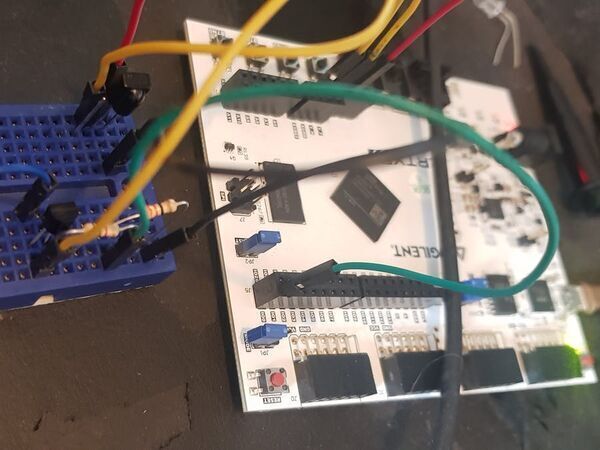
FPGA to FPGA IR Communication
"Communicating between FPGA up to 40 metres apart using IR modulation. Processing at the edge is a rapidly increasing application for embedded systems, often these edge nodes are connected using a RF link e.g. Zigbee, WiFi etc. However, there are applications where RF is not suitable for example when you want electrical noise kept to a minimum or when adding RF communication adds significantly to the cost of the system. In these cases simple communications can be implemented between a host and one or more slaves using Infra Red Communication. Depending upon the architecture of solution we choose we can achieve very fast data rates to transfer data between FPGAs." [...]

(WiFi) Mood Lamp
"In this Instructable, I will show you how to build a very easy and cheap mood lamp. The lamp can be upgraded with RGB LEDs and a WiFi-compatible microcontroller. Supplies: 4 Led's: red, yellow, green and blue (alternatively: two rgb Led's) The more Led's the brighter the lamp USB Cable 3D Printer 3,5mm Acrylic (can be thicker or thinner) Wemos d1 mini (not necessary if you don't need a WiFi controlled lamp)" [...]

4 Microphones Mixer Preamplifier
"Some time ago I was asked to solve the following problem: a small choir plays a number of four fixed microphones. The audio signals from these four microphones had to be amplified, mixed and the resulting signal had to be applied to an audio power amplifier.Because I couldn't find a tool to do this, I built one.That's what it's all about. " [...]
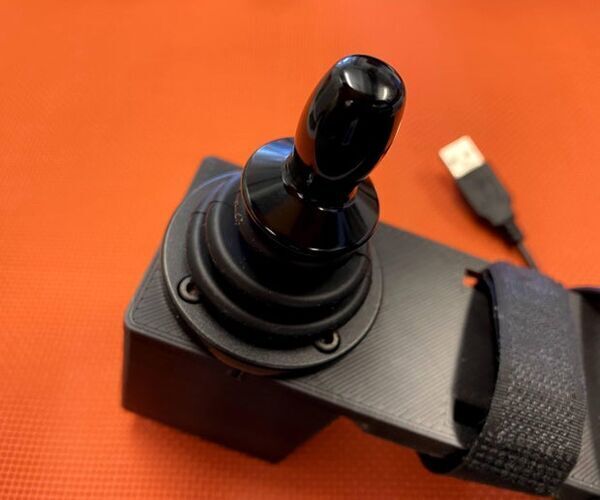
Hall Effect USB Joystick
"This instructables show how to use a industrial Hall Effect joystick to make a high presision USB joystick. There are another related instructables Tiny USB Joystick that can provide low cost solution ;> Normal USB joystick use 2 potentiometers as sensors on X-axis and Y-axis. There are a few limitations on potentiometer: not sensitive enough on minor movement (minor resistance change) physical contact in the sensor is easy worn out (short lifetime) the worn out in partial area make the axis movement return nonlinear value (return incorrect value) In contrast, Hall effect sensor is contactless in sensor part, so not easy worn out and give a lifelong precise value. " [...]
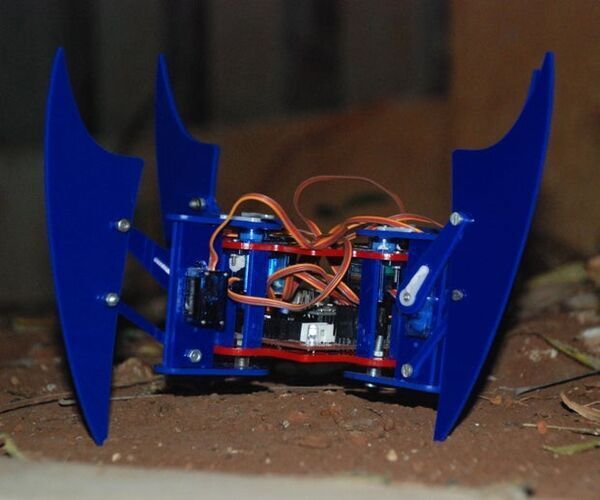
"Miles" the Quadruped Spider Robot
"Based on Arduino Nano , Miles is a spider robot that uses its 4 Legs to walk and maneuver. It uses 8 SG90 / MG90 Servo motors as actuators for the legs, consists of a custom PCB made to power and control the servos and the Arduino Nano.PCB has dedicated slots for IMU module, Bluetooth module and even IR sensor array to make the robot autonomous. Body is made from laser cut 3mm acrylic sheets, can be 3D printed as well. Its a great project for enthusiasts to explore inverse kinematics in robotics. The code and libraries,Gerber files and STL/step files for project will be made available on request. Miles is also available as a Kit, DM for details." [...]

The Ultimate Beer Pong Machine - PongMate CyberCannon Mark III
"Introduction The PongMate CyberCannon Mark III is the newest and most advanced piece of beer pong technology to ever be sold to the public. With the new CyberCannon, any person can become the most feared player at the beer pong table. How is this possible? Well, the CyberCannon Mark III combines a state-of-the-art Launching System, Auxiliary FlightControl System, and Aiming Calibration System to ensure that each ping pong ball is shot with the highest possible accuracy. Here's how it works: The PongMate's Launching System consists of a loading and shooting mechanism that was designed by top-level German and American engineers and guarantees maximum efficiency on the table. Load up the ball, press the button and shoot." [...]

SnakePedia
"A snake game, which is built on 8*8 LED dot matrix display with dedicated push buttons to control the movement. The Idea: Who doesn't want to play the retro games! It brings back old happy memories to people, where the pixel density wasn't that much as we have today, but we had games to play in those. In the era of modern high-end processor and graphics card, these games are considered to be the classics of gaming industry. What is SnakePedia: SnakePedia is nothing but our all time favorite snake game. It is built on a custom made 8*8 LED dot-matrix display, where micro-controller ATmega328P is used as display and movement controller." [...]
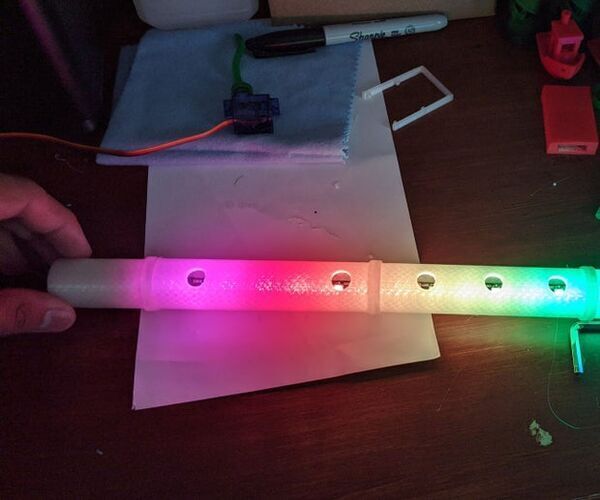
Rainbow Audio-Reactive Flute
"Hello! In this instructable I will be showing you the process of creating this audio-reactive, rainbow flute (known as a Bansuri). The flute has RGB LEDS inside and will change it's color based on the note played. Note that this project requires a 3D printer, as you need to print the flute, as well as a soldering Iron to assemble the electronics. The rest of the project supplies can be bought fairly cheaply, and all in all is fairly easy to assemble. Without further ado, here's how you can build it!" [...]
That's all Folks!



